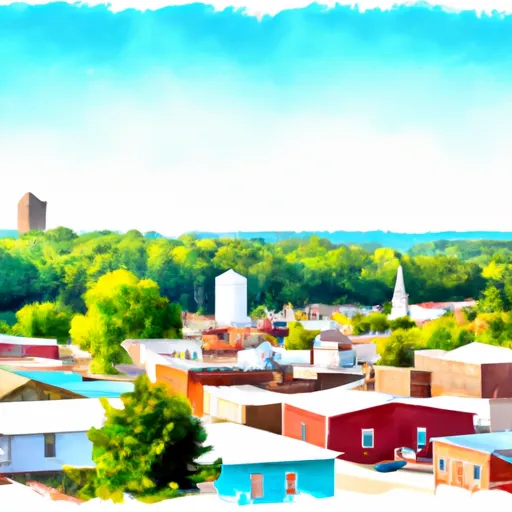-
 Snoflo Premium
Snoflo Premium
Get unlimited access to all our content
With no Ad interruptions! - Start Your Free Trial Login with existing account
Hode
Eden Index
Climate
8.2
•
Recreation
0.3
•
Community
1.9
•
Safeguard
3.8/10

Hode, Kentucky is a small community located in Harlan County, situated in the southeastern part of the state. The region experiences a humid subtropical climate, characterized by hot summers and mild winters. Summers in Hode are typically warm with temperatures averaging in the mid-80s Fahrenheit (around 30 degrees Celsius), while winters are mild with average temperatures in the mid-40s Fahrenheit (around 7 degrees Celsius).
Hode is surrounded by beautiful natural landscapes and is home to several water bodies, including the Martin's Fork River. This river provides opportunities for various outdoor recreational activities such as fishing, boating, and kayaking. The region also offers hiking and camping opportunities in nearby parks and forests, including Kingdom Come State Park and Black Mountain Off-Road Adventure Area.
The hydrology constituents in Hode are primarily influenced by the surrounding Appalachian Mountains. The area is abundant in rivers, streams, and springs, providing a rich water resource for the community. These waterways contribute to the diverse flora and fauna found in the region, making it an attractive destination for nature enthusiasts.
Overall, Hode, Kentucky offers a favorable climate, picturesque water bodies, and a range of outdoor recreation opportunities, making it an enticing destination for those seeking to connect with nature and enjoy various outdoor activities.
What is the Eden Index?
The Snoflo Eden Index serves as a comprehensive rating system for regions, evaluating their desirability through a holistic assessment of climate health, outdoor recreation opportunities, and natural disaster risk, acknowledging the profound impact of these factors on livability and well-being.
Climate Health Indicator (CHI): 8.2
Hode receives approximately
1179mm of rain per year,
with humidity levels near 83%
and air temperatures averaging around
13°C.
Hode has a plant hardyness factor of
6, meaning
plants and agriculture in this region thrive during a short period during spring and early summer. Most
plants will die off during the colder winter months.
By considering the ideal temperature range, reliable water supplies, clean air, and stable seasonal rain or snowpacks, the Climate Health Indicator (CHI) underscores the significance of a healthy climate as the foundation for quality living.
A healthy climate is paramount for ensuring a high quality of life and livability in a region, fostering both physical well-being and environmental harmony. This can be characterized by ideal temperatures, reliable access to water supplies, clean air, and consistent seasonal rain or snowpacks.
Weather Forecast
Streamflow Conditions
Big Sandy
Area Rivers
Big Sandy
Snowpack Depths
Big Sandy
Reservoir Storage Capacity
Big Sandy
Groundwater Levels
Recreational Opportunity Index (ROI): 0.3
The Recreational Opportunity Index (ROI) recognizes the value of outdoor recreational options, such as parks, hiking trails, camping sites, and fishing spots, while acknowledging that climate plays a pivotal role in ensuring the comfort and consistency of these experiences.
Access to outdoor recreational opportunities, encompassing activities such as parks, hiking, camping, and fishing, is crucial for overall well-being, and the climate plays a pivotal role in enabling and enhancing these experiences, ensuring that individuals can engage in nature-based activities comfortably and consistently.
Camping Areas
| Campground | Campsites | Reservations | Toilets | Showers | Elevation |
|---|---|---|---|---|---|
| Lower Twin Branch - John W. Flannagan Reservoir | None | 1,434 ft | |||
| Warriors Path State Park | 134 | 1,326 ft | |||
| Grapevine - Fishtrap Lake | 200 | 851 ft | |||
| Persimmon Ridge City Park | 45 | 1,733 ft | |||
| Cabwaylingo State Forest | None | 1,161 ft | |||
| Breaks InterState Park | 138 | 1,798 ft | |||
| High Knob | 77 | 3,608 ft | |||
| Cranesnest - John W. Flannagan Reservoir | None | 1,500 ft | |||
| Bark Camp | 71 | 2,839 ft | |||
| Pound River - John W. Flannagan Reservoir | None | 1,653 ft |
Catastrophe Safeguard Index (CSI):
The Catastrophe Safeguard Index (CSI) recognizes that natural disaster risk, encompassing floods, fires, hurricanes, and tornadoes, can drastically affect safety and the overall appeal of an area.
The level of natural disaster risk in a region significantly affects safety and the overall livability, with climate change amplifying these risks by potentially increasing the frequency and intensity of events like floods, fires, hurricanes, and tornadoes, thereby posing substantial challenges to community resilience and well-being.
Community Resilience Indicator (CRI): 1.9
The Community Resilience Indicator (CRI) recognizes that education, healthcare, and socioeconomics are crucial to the well-being of a region. The CRI acknowledges the profound impact of these elements on residents' overall quality of life. By evaluating educational resources, healthcare accessibility, and economic inclusivity, the index captures the essential aspects that contribute to a thriving community, fostering resident satisfaction, equity, and social cohesion.

